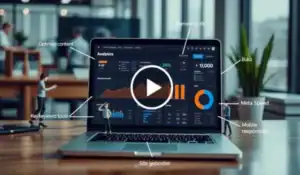How to recover website traffic after a Google update. If the helpful content update last year felt like an uppercut, then the Google Core Update and Spam Update in March 2025 delivered a knockout punch. But being knocked down doesn’t mean the fight is over. In this guide, we’ll break down what Google is looking for and, more importantly, how you can recover your site’s traffic and rankings after the latest updates and improve website traffic.
What Is the March 2025 Google Update About?
The Google Core and Spam Updates 2025 primarily target spammy or low-quality websites. But what does “low quality” actually mean?
Google aims to reduce unoriginal content in search results. They classify low-quality websites as:
- Pages with poor user experience.
- Content created primarily for search engines, not for people.
- Sites built just to match ultra-specific search queries without offering true value.
Additionally, Google’s updated spam policies focus on:
- Expired domains are reused for spam or PBNs.
- Mass content generation with or without AI.
- Site reputation abuse, like paying for mentions on authoritative websites.
If you’ve been using gray-hat SEO tactics, operating a Content Farm, or gaming the system, this update likely hit you hard.
However, even ethical site owners have seen ranking drops. Let’s discuss actionable ways to recover from the Google Core Update 2025.
Optimize Ads to Improve User Experience
Heavy ad placements are now a major red flag for Google. Sites managed by ad platforms like Ezoic or Mediavine often become clogged with intrusive ads that:
- Block access to content and website traffic.
- Have difficult-to-close buttons.
- Frustrate users with endless pop-ups.
Recovery Tip:
Manually control your ads. Limit pop-ups, reduce ad density, and prioritize clean, user-friendly layouts to comply with the Helpful Content Update 2025 and improve website traffic.
Strengthen Internal Linking Based on User Intent
Internal linking must go beyond just SEO. It’s about genuinely helping your readers. For example, if your article lists online jobs for seniors, include internal links guiding them to application guides or resume tips.
Recovery Tip:
Understand the deeper user intent and provide internal or external links that help solve the reader’s full problem, not just part of it.
Replace AI Content Farming with Original Research
Google is fine with AI-assisted content creation, but it penalizes low-quality and uninspired AI content. Rather than copying data from others, conduct your experiments.
Example: If you’re reviewing the best AI image generators, personally test each tool, document your prompts, and present your findings.
Recovery Tip: Build a research-first content strategy. Use AI to support, not substitute, your genuine research.
Update Your Old Content Regularly: Website Traffic
Even the best content becomes outdated. In rapidly evolving industries, like AI tools or digital marketing, what ranked last year may not be relevant today.
Recovery Tip: Audit and update your content at least once every 12 months. Refresh examples, update data points, and realign content with the latest search intent.
Diversify Your Traffic Sources Beyond Google
Depending solely on SEO traffic is dangerous in 2025. Google can (and does) change its rules without warning.
Recovery Tip: Expand to social media, email marketing, YouTube, and community forums. Build owned audiences who follow you, not just your search rankings and improve website traffic.
Build Strong Authority
Google rewards trusted figures with a strong online presence. Especially in YMYL (Your Money or Your Life) niches like health, finance, and law, authority is everything.
Recovery Tip: Grow your authority through guest posts, podcasts, speaking events, and YouTube channels. Let Google and your audience see you as a leading expert.
Smartly Leverage Paid Traffic
Paid ads can complement your SEO strategy if done right.
Recovery Tip: Only run Google Ads on high-intent commercial pages, not blog posts targeting informational keywords.
Optimize for positive ROI, not just vanity traffic. Building an email list through ads is one of the best investments for your future.
Conclusion
Recovering from a Google Core Update 2025 or Spam Update isn’t just about fixing SEO. It’s about building a better, more resilient digital presence and improve website traffic.
Remember these fundamentals:
- Prioritize user experience.
- Help users beyond the surface intent.
- Do original research.
- Keep your content fresh.
- Build authority everywhere online.
- Diversify your traffic streams.
- Use paid traffic strategically.






